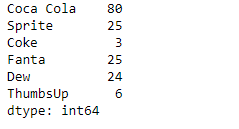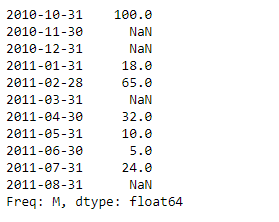Python Pandas Series.count()
Pandas系列是一个带有轴标签的一维ndarray。标签不需要是唯一的,但必须是一个可散列的类型。该对象支持基于整数和标签的索引,并提供了大量的方法来执行涉及索引的操作。
Pandas Series.count()函数返回给定Series对象中非NA/null观测值的数量。
语法: Series.count(level=None)
参数:
level : 如果轴是一个多指标(分层),沿着一个特定的层次计数,折叠成一个更小的系列。
返回 : nobs : int 或 Series (如果指定级别)
示例#1:使用Series.count()函数来查找给定系列对象中非缺失值的数量。
# importing pandas as pd
import pandas as pd
# Creating the Series
sr = pd.Series([80, 25, 3, 25, 24, 6])
# Create the Index
index_ = ['Coca Cola', 'Sprite', 'Coke', 'Fanta', 'Dew', 'ThumbsUp']
# set the index
sr.index = index_
# Print the series
print(sr)
输出 :

现在我们将使用Series.count()函数来查找给定系列对象中非缺失值的计数。
# find the count of non-missing values
# in the given series object
result = sr.count()
# Print the result
print(result)
输出 :

正如我们在输出中看到的,Series.count()函数已经成功地返回了给定系列对象中非缺失值的数量。
示例#2 :使用Series.count()函数来查找给定系列对象中非缺失值的数量。给定的系列对象包含一些缺失的值。
# importing pandas as pd
import pandas as pd
# Creating the Series
sr = pd.Series([100, None, None, 18, 65, None, 32, 10, 5, 24, None])
# Create the Index
index_ = pd.date_range('2010-10-09', periods = 11, freq ='M')
# set the index
sr.index = index_
# Print the series
print(sr)
输出 :

现在我们将使用Series.count()函数来查找给定系列对象中非缺失值的数量。
# find the count of non-missing values
# in the given series object
result = sr.count()
# Print the result
print(result)
输出 :

正如我们在输出中看到的,Series.count()函数已经成功地返回了给定系列对象中非缺失值的数量。
 极客教程
极客教程